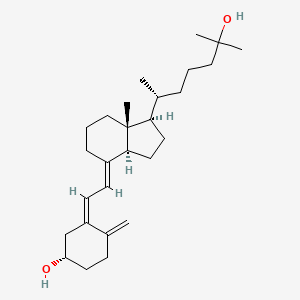Wednesday, October 29, 2025
FDA Approves Palsonify (paltusotine) for the Treatment of Acromegaly in Adults
Tuesday, October 4, 2022
Daily Multivitamin May Protect Against Cognitive Decline in Older Adults
A daily multivitamin may provide cognitive benefits for older adults, according to a study published online Sept. 14 in Alzheimer’s & Dementia.
Laura D. Baker, Ph.D., from the Wake Forest University School of Medicine in Winston-Salem, North Carolina, and colleagues assessed whether daily use of cocoa extract (containing 500 mg/day flavanols) versus placebo and a commercial multivitamin-mineral (MVM) versus placebo improved cognition in 2,262 older women and men (mean age, 73 years).
The researchers found that cocoa extract had no effect on global cognition. However, compared with placebo, daily MVM supplementation resulted in a statistically significant benefit on global cognition, with a more pronounced effect seen in participants with a history of cardiovascular disease. Benefits of MVM were also seen for memory and executive function. There were no significant interactions observed between cocoa extract and MVM for any of the cognitive composites.
"Our study showed that although cocoa extract did not affect cognition, daily multivitamin-mineral supplementation resulted in statistically significant cognitive improvement. This is the first evidence of cognitive benefit in a large longer-term study of multivitamin supplementation in older adults," Baker said in a statement. "It's too early to recommend daily multivitamin supplementation to prevent cognitive decline. While these preliminary findings are promising, additional research is needed in a larger and more diverse group of people."
Tuesday, October 15, 2019
Is Green Tea a Fad or a Real Health Boost?
"Clinical trials related to green tea are still in their early stages," said Nancy Farrell Allen, a registered dietitian nutritionist in Fredericksburg, Va. "I say drink it, enjoy it. It's not going to hurt, and it might have worthy benefits to it. But nutrition is a science, and it takes time for our understanding to evolve."
"This compound can be even stronger than vitamin C and E, which are very, very strong antioxidants," Schneider said. Antioxidants help prevent damage to cells.
"They dry and blacken and ferment a little, giving black tea that darker, richer flavor," Allen said. But this process also reduces levels of catechins in black tea.
But a 2016 evidence review by the Cochrane Library concluded that there is "insufficient and conflicting evidence to give any firm recommendations regarding green tea consumption for cancer prevention."
"A lot of people are adding processed white sugar to their green tea, which really makes something beautiful and healthy into something unhealthy," she said.
"There are some studies that say having milk in green tea can actually block the effects of you absorbing the antioxidant," Schneider said. "If it was me, I'd drink it straight up."
Friday, October 4, 2019
FDA Approves Sorilux for Adolescent Plaque Psoriasis

Friday, April 13, 2018
Compound prevents neurological damage, shows cognitive benefits in mouse model of Alzheimer’s disease

“The pursuit of interventions to prevent or delay Alzheimer’s and related dementias is an important national priority,” said Richard J. Hodes, M.D., director of the NIA. “We are encouraging the testing of a variety of new approaches, and this study’s positive results suggest one avenue to pursue further.”
“We are encouraged by these findings that see an effect in this Alzheimer’s disease model,” said Dr. Bohr. “We are looking forward to further testing of how NR or similar compounds might be pursued for their possible therapeutic benefit for people with dementia.”
Friday, April 6, 2018
High vitamin D levels may help prevent cancer
Yet more comprehensive research needs to be conducted, as to date, the majority of studies have been conducted throughout American and European populations, and more studies focusing on Asian populations are necessary.
It is vital to determine whether the effects are the same in non-Caucasian populations, since Vitamin D metabolism and concentrations differ dependant on ethnicity.
The study published by the BMJ was carried out to determine if vitamin D was linked to site specific and total cancer.
Data spanning nine public health centres across Japan was analysed, from 33,736 female and male participants between the ages of 40 and 69 years old.
Participants were required to disclose a comprehensive overview of their lifestyle, diet and medical history and have blood samples taken to assess their vitamin D levels. Factors such as seasons affected vitamin D levels; summer and autumn typically produced higher levels compared to spring or winter. Samples were then assigned to one of four groups, based on levels.
Researchers then monitored the study participants for a mean period of 16 years, during which 3,301 new cancer cases were registered.
Once multiple known cancer risk factors had been accounted for, including weight (BMI), physical activity, age, dietary factors, smoking and alcohol intake, researchers discovered that high levels of vitamin D reduced the overall risk of cancer by 20% in both women and men.
Higher levels were linked to a 30-50% lower relative risk of liver cancer, and more so in men than women. No cancers exhibited a higher risk connected to high vitamin D levels, and there was no evidence of a link to prostate or lung cancer.
Adjustments were made for dietary and other factors to confirm the strength of the findings, but this did little to affect the results. One limitation of the study was an insufficient number of organ specific cancers. In addition, even with the risk factor adjustments, there is no absolute certainty that the results were skewed by unidentified factors. For this reason, no concrete conclusions about cause and effect can be asserted.
The large sample size for overall cancer, large number of blood samples tested and the extensive follow up period were vital strengths of the study. The result reinforce the theory that vitamin D has a role in defending against the risk of cancer, but the authors emphasize that vitamin D may carry additional health benefits too, that were not measured in this study.
Further studies are needed to clarify the optimal concentrations (of vitamin D) for cancer prevention."
Further studies are needed to clarify the optimal concentrations (of vitamin D) for cancer prevention."Ref : https://www.eurekalert.org/pub_releases/2018-03/b-hvd030618.php
Wednesday, June 21, 2017
Vitamin A Compound Might Aid in Colon Cancer Fight

"Retinoic acid has been known for years to be involved in suppressing inflammation in the intestine," said study senior author Dr. Edgar Engleman, professor of pathology and medicine at Stanford University School of Medicine in Palo Alto, Calif.
"We wanted to connect the dots and learn whether and how retinoic acid levels directly affect cancer development," Engleman added.
Friday, February 10, 2017
FDA Approves Rayaldee (calcifediol) to Treat Secondary Hyperparathyroidism in Patients with Chronic Kidney Disease
About Rayaldee
Friday, December 23, 2016
One-third of osteoporotic women taking oral bisphosphonates have elevated risk for bone fracture

"We know that taking bisphosphonates decrease fracture risk compared to those not taking these drugs," Dr. Imel said. "But what about those women who weren't getting the anticipated benefit and are not improving bone density or even are losing bone density? What predicted that? The purpose of this study was to focus attention on those not doing well, in order to begin to decrease the odds of future fractures in this large group of vulnerable patients.
"Not everyone responds the same way to oral bisphosphonates or any drug. Various factors could convey continued risk of fracture in spite of bisphosphonate therapy, including other medical problems and risk factors for falling. Since we know that such a high percentage of women continue to have elevated fracture risk we -- doctors and patients -- need to focus on these factors," Dr. Imel said. "For example, we found that women who had other medical conditions in addition to low bone density--a frequent occurrence in this older population--had higher fracture risk. Taking some medications in combination with bisphosphonates seemed to increase fracture risk. However, having more medical conditions and taking more drugs are most likely markers of heightened risk rather than causative factors."
"I always tell my osteoporosis patients, 'Don't fall,'" said Dr. Imel. "They usually chuckle, and then we talk about things they can do to decrease the risk of falling, including proper footwear and assistive devices. Many patients are reluctant to use a cane or a walker. I try to get them to understand the importance of using any tool that decreases the chance of falling."
Tuesday, December 13, 2016
Taking vitamin D with quetiapine can help avoid new-onset diabetes risk
 quetiapine.
quetiapine."Interestingly, vitamin D on its own doesn't lower diabetes risk, but it certainly defends against the insulin-lowering effects of quetiapine," elaborates lead author Takuya Nagashima. "We clarified the molecular mechanisms of how quetiapine causes hyperglycaemia using datasets in a genomics data repository. Through this we found that quetiapine reduces the amount of a key enzyme called PI3K that gets produced. Vitamin D stops quetiapine from lowering PI3K production."
Ref : http://www.kyoto-u.ac.jp/en/research/research_results/2016/160523_2.html
"Databases like FAERS aren't just for making drug regulations; they have so much potential for side-effect relief using pre-existing drugs," says Kaneko. "There's a lot we can hope for from reverse translational research like this. "
Monday, November 11, 2013
Blueberries, Red Grapes May Boost Body's Immune Function
"Their synergy with vitamin D to increase CAMP gene expression was significant and intriguing," said Gombart, an associate professor in the university's college of science. "It's a pretty interesting interaction."
Thursday, June 6, 2013
Cancer Fighting Foods.............
Thursday, May 16, 2013
Carnitine supplement may improve survival rates of children with heart defects
"My hope is this is going to have a major, major impact on survival of babies," Black said. About half the babies born with heart defects have excessive, continuous high pressure on their lungs from misdirected blood flow. Early surgery can prevent full-blown pulmonary vascular disease, but scientists are finding more subtle disruptions in the signaling inside blood vessels walls that can be problematic -- even deadly -- up to 72 hours after surgery.
The good news is the changes are reversible and that carnitine speeds recovery and can even prevent the damage in a lamb model of these human heart defects, according to studies published in the journal Pediatric Research.











